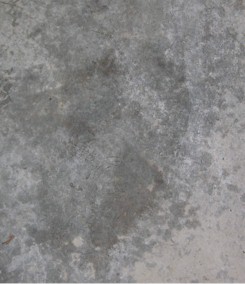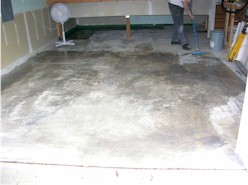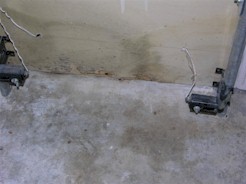One day in August, I opened the
door to the garage and was literally unable to see the windows
at the top of the garage doors. The place smelled like
a fish market and was so steamy that visibility was really limited.

The mold had been overwhelming. I
had been dislocated by the chaos of flooding and restoration;
and I was often disoriented and too tired to focus. The
conditions under the house and in the garage just did not have
my attention in the first months in the house.

Moreover, despite the thousands
of dollars paid to various building and air quality consultants,
no one seemed to take the garage situation seriously. There
was a report commissioned by my own insurance company stating
there was efflorescence, but not dotting the "i's" and
crossing the "t's" in a way that made it clear that
this is because moisture is pushing particulates to the surface,
meaning either that the vapor barrier was failing or did not
perhaps exist.
I became more and more observant
and realized that in addition to constant accumulations of "concrete
dust and powders," there was also occasional but not lasting
puddling of water, giving the concrete a mottled appearance,
like a slab that never cured.
A few months ago, I decided to
conquer my office, make it a usable space. In April
last year, I had already removed all the carpeting because
it did not smell good. A few months later, I removed
all the furniture and painted the walls, but the wall contiguous
to the garage remained tacky to the touch for days. I
realized I could not go any further in the indoor space without
tackling the garage.
Several mutually exclusive recommendations
had been made by contractors and "experts". These
ranged from using a jack hammer to remove the slab
to sealing the concrete from the top. The
people with whom I spoke admitted they had limited experience
with the various products on the market (I had tried one five
years ago, but it failed.) Unfortunately, none of the local
contractors with whom I spoke inspired much confidence so I began
a web search and ended up at solvingconcreteproblems.com. Grant
Loyd, the owner of the site, was very sure of his product as
well as helpful in a number of other ways.
He said his sealant will penetrate
down as much as four inches. As it does so, it forces loose
materials to the surface. He was absolutely right. As
the sealant dried and floor began to have a slightly more even
appearance (something not promised), the
floor became totally dusty, more and more so for days. I
filled many dust pans with all that I swept up.
This sealant is almost odorless,
well, it probably is odorless but there is a smell of wet concrete
for several days after application.
 |
This picture is, of course, boring,
but it shows a floor that has patches of very moist areas
interspersed with some that are less damp. |
 |
The back corner where a previous attempt
to seal with a product recommended by Home Depot failed. The
two black puddles are visible. According to the information
imparted at the mold seminar, mold does not really grow "in"
concrete, but it grows "on" particulates touching concrete. Usually,
it is penicillium that grows on concrete. |
 |
This is simply the preparation for
the sealing.
The green garage sealant was removed using a natural orange
stripping agent and TKO Orange. |
 |
This is one of the few places in
the garage where the drywall actually touches the slab. There
was mold growing up the wall for about 18 inches.
Efflorescence can also be clearly seen on the floor where
the moisture has been pushing its way to the surface. |
Retrospective Assessment
My problem has been that the
two areas with the most moisture are also the two that happen
to be directly involved with the HVAC system. There are
ducts in the crawl space and the furnace is in the garage. I
ran an experiment in which I put a single drop of citrus oil
on the floor in the garage to see how long it would take to smell
this in the house. The room closest to the garage, where
my computer is, was the first where I could detect the citrus
oil, in less than 30 seconds. It took 2-3 minutes before
the oils could be detected upstairs.
I had told all the various contractors
and inspectors who came to the house that the absolute worst
air in the whole house was near my computer, so bad that
I have occasionally had to move the computer, but eventually
I have to return to the desk because so much of the house
is non-functional that only one room has space for the printer
and peripherals.
The two black puddles of standing
water that were found in the garage were on the back side of
the wall behind the computer. This makes one feel very
dull witted.
When
the water was removed, the concrete disinfected and sealed,
the odor stopped. In
fact, it stopped so much that I can imagine an
end to the remediation process. Next week, I am going
to put down new flooring in the disassembled office. If
all goes well, the process of replacing contaminated materials
with healthy ones will be continued.
Comments
Some of the visitors
to this site have been sharing their stories. One particularly
poignant story came from someone who works in place where some
moldy newspaper was found in a planter. Besides the mold
problems, she became ghastly sensitive to news print.
I understand totally. When
toxic chemicals were used in the remediation of the crawl space,
I became so sensitive to plastic that I couldn't stand the smell
of my computer keyboard or mouse!
Ingrid
Naiman
16 February 2006
Update: The sensitivity
to the smell of plastic passed after a few months and the odor
no longer affects me in the same way. Several more applications
of the sealant were applied and finally in October-November,
the floor seemed to be dry. We then applied an epoxy sealant
on top of the penetrating one.
7 December 2006

Continued
on next page 









